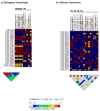Identifying the genotype behind the phenotype: a role model found in VKORC1 and its association with warfarin dosing
- PMID: 17465713
- PMCID: PMC3112050
- DOI: 10.2217/14622416.8.5.487
Identifying the genotype behind the phenotype: a role model found in VKORC1 and its association with warfarin dosing
Abstract
Genotype-phenotype studies in pharmacogenomics promise to identify the genetic factors that contribute substantially to variation in individual drug response. While most genetic association studies have failed to deliver this promise, several recent examples serve as a reminder that these associations do exist and can be identified when investigated using well-designed studies. Here, we describe the path taken to identify the association between common vitamin K epoxide reductase complex subunit 1 genetic variation and warfarin dosing in patients. We also describe the key elements that led the way, such as definition of the phenotype, confirmation of a genetic component, determination of biological plausibility and selection of genetic polymorphisms. We also describe several avenues that are yet to be explored for the specific vitamin K epoxide reductase complex subunit 1 warfarin example that can also be generalized as future directions for many genetic association studies in pharmacogenomics. These future avenues will be best explored using diverse approaches encompassing clinical, statistical and genomic methods currently being developed for genotype-phenotype studies in human populations.
Figures

References
-
- Watson JD, Crick FH. Molecular structure of nucleic acids; a structure for deoxyribose nucleic acid. Nature. 1953;17:737–738. - PubMed
-
- Venter JC, Adams MD, Myers EW, Li PW, Mural RJ. The sequence of the human genome. Science. 2001;291:1304. - PubMed
-
- Initial sequencing and analysis of the human genome. Nature. 2001;409:806. - PubMed
-
- Motulsky A. Drug reactions, enzymes and biochemical genetics. JAMA. 1957;165:835–837. - PubMed
-
- Fan JB, Chee MS, Gunderson KL. Highly parallel genomic assays. Nat Rev Genet. 2006;7:632–644. - PubMed
Publication types
MeSH terms
Substances
Grants and funding
LinkOut - more resources
Full Text Sources
Medical
Molecular Biology Databases
Research Materials
